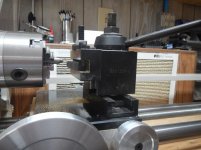You're not actually that much of a moron are you? It has to be an act.. That's the most ridiculous, nonsensical pile of drivel I've read in quite some time. Apparently you're unable to process an analogy. Where did I say using an AXA, OXA or an A2Z is illogical? I said using anything smaller than a BXA is not as good of an option as using the BXA, simple really. WHY IS THAT? Because it's high enough to use without a spacer. Tool posts aren't designed to be used with spacers under them. Will they work like that? Possibly, but from a machining and a correct tool for the job standpoint it makes more sense to use the tool post that is the right height. PERIOD, that's not open for discussion or interpretation. Small lathes require smaller tool posts.. The difference in physical size of an AXA and a BXA is marginal, it won't affect the performance or operation of the Porper whatsoever. If a BXA is the correct height, then an AXA may be acceptable to some if they think a spacer is the best option, but to go smaller, 60% of the size of an AXA is NOT, 100% should not be an option if you want to do things the right way. You either don't care to use proper tools or you just want to argue about semantics. You are wrong, plain and simple, anything smaller than an AXA is too small for that machine. Sure, someone could jury rig a smaller one up to work, or maybe they modified the tool post mount to be higher, but in stock form it needs a taller tool post than an OXA.
You don't seem to understand that newbies come on these threads. If someone like you with little or no machine knowledge comes in here and reads your post and buys an OXA for their Porper, they're going to be in for a rude awakening because of your limited capacity and poor suggestion. I circumvented that from happening.
Go ahead and write more ignorant rants that aren't based in fact. Just know that I'm done talking to you, I've had my fill of idiocy for today! And thanks for the laugh! You, matching wits with me, yet you couldn't understand how a simple analogy applies... Hahaha. #BozoTheCuemaker
